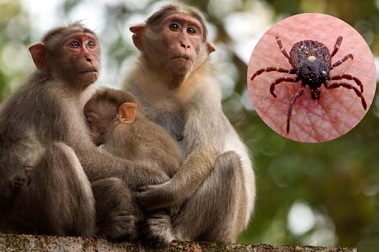BREAKING Medical News! Fatal Monkey Fever (Not Mpox) Outbreak Escalating In Karnataka-India With 53 Infections and 2 Deaths So Far!
Nikhil Prasad Fact checked by:Thailand Medical News Team Feb 04, 2024 1 year, 2 months, 3 weeks, 1 day, 18 hours, 16 minutes ago
Medical News: In a shocking turn of events, Karnataka, India, is grappling with a severe outbreak of Kyasanur Forest Disease (KFD), commonly known as monkey fever.
 Fatal Monkey Fever Outbreak Escalating In Karnataka-India
Fatal Monkey Fever Outbreak Escalating In Karnataka-India
With 53 Infections and 2 Deaths So Far!
The viral hemorrhagic fever, transmitted through tick bites, has raised significant health concerns, with 53 reported cases and two fatalities so far. This
Medical News report delves into the details of the outbreak, its symptoms, preventive measures, and the challenges faced by health authorities.
The Spread of Monkey Fever
Monkey fever, caused by the Kyasanur Forest Disease (KFD) virus, has manifested in 53 confirmed cases in Karnataka's Uttara Kannada district as off 4
th of February 2024. Among those affected, 16 patients are currently admitted to hospitals, while the remaining 37 are being treated at home. The outbreak is particularly concentrated in Siddapur taluk, emphasizing the need for swift and comprehensive intervention. Local health authorities believe that hundreds more could be infected across various village communities in the region and are currently conducting health screenings.
Understanding Kyasanur Forest Disease
Kyasanur Forest Disease, endemic to Southern India, is a tick-borne viral hemorrhagic fever. The virus belongs to the same family as yellow fever and dengue, posing a significant threat to human health. Humans contract the disease through tick (Haemaphysalis spinigera) bites or by coming into contact with infected animals, primarily monkeys. The virus causes symptoms such as fever, severe headache, muscle pain, vomiting, and bleeding, with advanced cases leading to neurological complications.
Early Detection and Symptoms
Health authorities stress the importance of early detection, as symptoms typically appear within 3 to 5 days of infection. Initial signs include high fever, severe body ache, headache, redness of eyes, cold, and cough. Dr Neeraj B, the Uttara Kannada District Health Officer, emphasizes the need for vigilance and urges people to seek medical attention promptly if they experience symptoms.
Monkey fever infection presents with symptoms such as abrupt onset of fever, severe headache, muscle pain, and fatigue. Patients may experience chills, dizziness, and photophobia. As the disease progresses, gastrointestinal symptoms like vomiting and diarrhea may occur. In severe cases, hemorrhagic manifestations such as nosebleeds and bleeding from the gums may be observed. Neurological complications like tremors, gait abnormalities, and mental confusion can occur in advanced stages.
Preventive Measures and Challenges
In the absence of an effective vaccine, the focus shifts to preventive measures and awareness campaigns. Dr Neeraj B outlines the precautions, including the use of repellent oil, regular handwashing, and avoiding contact with animals, especially in high-risk areas. The challenges faced by health authorit
ies include the absence of vaccines for the last two years and the need for proactive measures to curb the spread of the disease.
Tragic Case and Death Audit
Highlighting the severity of the outbreak, an 18-year-old girl succumbed to monkey fever in the Boppanamane village of Aralikoppa gram panchayat. This marks the first death in 2024. Dr Rajesh Suragihalli, the District Health Officer, reveals that despite being a non-KFD area for almost nine years, the girl's low haemoglobin levels and delayed treatment contributed to the unfortunate outcome. A detailed death audit is underway to ascertain the primary cause of death.
It was reported that one more person has died due to Kyasanur Forest Disease (KFD), increasing the death toll due to the viral infection to two this year. A 79-year-old person, a native of Sringeri taluk in Chikkamagaluru, died in a private hospital at Manipal in Udupi district on Friday.
Vaccination Challenges and Hope for the Future
The unavailability of vaccines for the past two years has posed a significant challenge in controlling the outbreak. However, there is hope on the horizon as a Hyderabad-based company is set to manufacture vaccines for Kyasanur Forest Disease. The Indian Immunological Company, in collaboration with ICMR-National Institute of Virology, is working on developing a vaccine, with the transfer of the virus strain expected in February.
Proactive Health Department Measures
In the absence of vaccines, the Karnataka Health Department has implemented various proactive measures to control the spread of KFD. These include the distribution of DEPA oil, an effective repellent against ticks, intensive sampling, rapid response teams for early intervention, education and awareness programs, and collaboration with other departments to ensure comprehensive strategies.
Conclusion
The alarming surge of monkey fever cases in Karnataka demands immediate attention and coordinated efforts from health authorities, communities, and the public. While challenges persist, including the lack of available vaccines, proactive measures, awareness campaigns, and ongoing research provide hope for managing and eventually eradicating the Kyasanur Forest Disease. Vigilance, early detection, and adherence to preventive measures remain crucial in safeguarding public health in the affected regions.
For the latest
Medical News, keep on logging to Thailand Medical News.
